 |
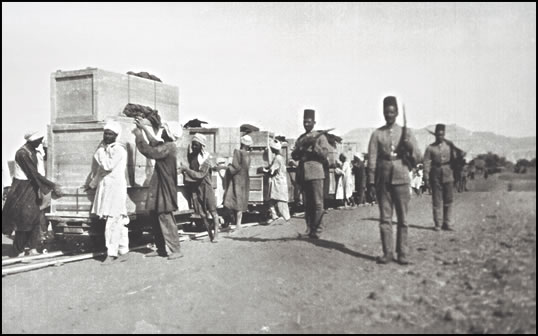 |
| In the early 1930s, Gaddis photographed the removal to Cairo of artifacts-—under armed guard—from the newly discovered tomb of Tutankhamun. |
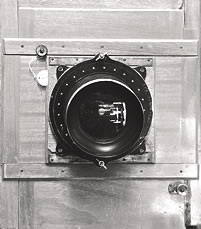 |
| Built in the 1860s and purchased by Gaddis in 1906, this wooden box camera went with Gaddis to countless towns, villages and archeological sites across Egypt over more than a half-century. |
On the street level of the Sofitel Winter Palace Hotel, facing the Nile River just minutes from the Luxor Temple, the elegant, old-fashioned storefront of Gaddis & Co. welcomes visitors with signs for books, jewelry, silverware and other souvenirs. Inside, guests are greeted by racks of curios, from alabaster bowls and stone replicas of ancient gods to pharaonic-style bead necklaces. Its walls, however, enshrine hundreds of books and vintage photographs in a one-of-a-kind collection picturing Luxor views, temple ruins and tourists, mostly from the early 20th century. And as if on center stage, there sits a large, wooden box camera: the tool that has lent permanence to the unfolding history of Egypt. A relic in its own right, and one with no shortage of stories to tell, it belonged to Gaddis & Co.’s founder and one of the earliest Egyptian studio photographers on record, Attiya Gaddis.
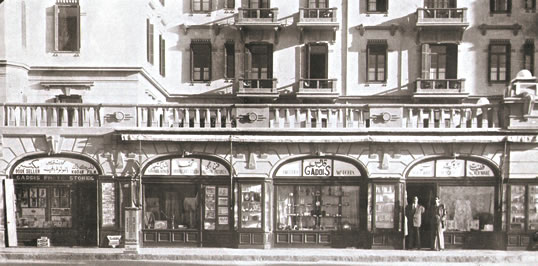 |
| By the time this photo was made in 1944, Attiya Gaddis, who stands with an unidentified friend on his left, had run his studio and shop, Gaddis & Co., on the street level of Luxor’s Winter Palace for 32 years. |
For many people over the past 150 years, the very idea of visiting Egypt began with photographs of artifacts and monuments. As the country is one of the world’s most popular photographic subjects, it is of little wonder that the enduring allure of travel to Egypt—and to Upper Egypt’s “Land of the Pharaohs” in particular—has been powered by an abundance of images dating back to the earliest days of photography.
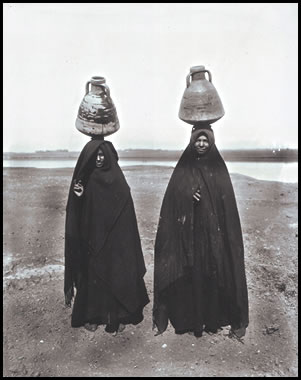 |
| In the 1920s and ‘30s, Gaddis became a master of the popular “genre portrait,” a style that reflected everyday life and showed people as “types” without identifying individuals, including the water carriers, above, and the young Nubian man with a mule, below. Both images subtly capture an ease on the part of the subjects before the camera that is often absent in comparable images by non-Egyptian photographers. |
In January 1839, members of the French Academy of Sciences were introduced to daguerreotypes, one-of-a-kind images fixed on highly polished, silver-plated sheets of copper. They immediately identified photography’s potential for documenting the remains of ancient civilizations, and that same year the first photographers arrived in Egypt.
For several decades afterward, European photographic pioneers accumulated field experience in which they tested technical advances including shorter exposure times, easily prepared, reproducible negatives and the explosive mixture of magnesium filings and gunpowder that became known as “flash”—essential for lighting dark interiors of temples and tombs. The images these early photographers created of Egypt and its people became immensely popular, mainly in Europe and North America, where they appeared in books and on postcards and collectibles, prompting many a steamship voyage. Photographs of Egypt helped create what became mass tourism and, over time, they have helped sustain it.
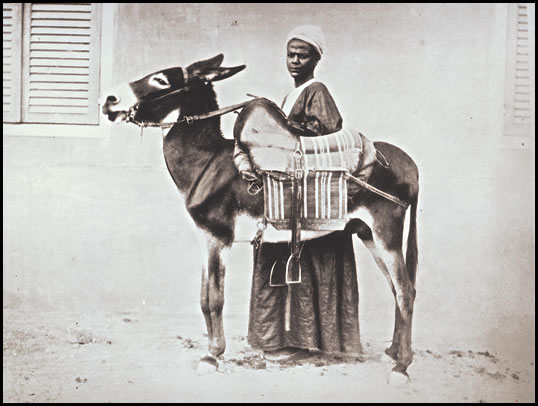 |
Economics and politics helped, too: Well before Thomas Cook launched his steamer tours up the Nile in 1886, Egypt was attracting foreigners in large numbers who sought not the country’s past but its highly profitable, modernizing present. Each year from 1857 to 1861, some 30,000 foreigners entered Egypt, many with the intention of setting up a business, a residence, or both. Egypt’s foreign communities swelled further between 1861 and 1865 as the us Civil War stalled cotton production in the American south. This enriched Egypt, as it stepped in to boost cotton supplies to the textile industries of Europe. Egypt experienced a period of intense development as immigrants, entrepreneurs and adventurers flocked in. Historian David Landes compared it to the Alaskan gold rush when he called it “Klondike on the Nile.”
Whereas photographers had previously visited Egypt for image-gathering expeditions, as of the 1860s some established permanent studios in Alexandria, Cairo, Luxor and the boomtown of Port Said, all to serve tourists and the thriving international market for photographs from Egypt. As photography became more accessible, the studio photographers also filled the growing demand for portraits from the foreign community and well-to-do Egyptians.
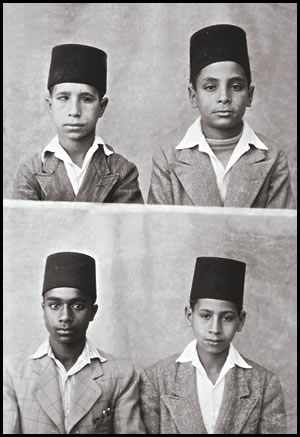 |
| Gaddis’s images also make up an extensive visual record of ordinary people. Beginning in the early 1920s, British rule required Egyptians to carry photographic identity cards, and Gaddis & Co. made thousands of portraits for them. To economize on materials, Gaddis often exposed parts of the same plate at different times with different subjects, as in this composite, which shows four students. |
While some historians have assumed it was Islamic objections to human figural representation in art that prevented Egyptians from becoming photographers, the real reasons were economic. Indeed, the first Egyptian photographer on record, Colonel Mohammed Sadiq Bey (1822-1902), focused his lens on those most sacred of Islamic places, producing the earliest photographic images of Madinah in 1862 and of Makkah and the pilgrimage, or Hajj, in 1880.
Foreigners, however, dominated the image-making trade because of the overwhelming advantages they enjoyed, including tax exemptions, lower import duties on commodities, and the access to capital to purchase photographic equipment and supplies from Europe. They also had easy access to training, unavailable to Egyptians until they began working for foreign photographers around the turn of the 20th century, apprenticing with studio photographers or helping archeologists. Although we have little information about the individual careers of many of these early professionals, the thousands of surviving samples of their works suggest a trend to establish studios in provincial towns, away from foreign competition in the capital and Alexandria. One of the earliest and, to date, the best documented is the Luxor studio of Attiya Gaddis, thanks in large part to his family’s continuous involvement in the business and preservation of Gaddis’s images.
Born in the village of Tot near Luxor in 1889, Attiya Gaddis attended a Christian school and apprenticed as a boy to a foreign photographer. This was probably Antonio Beato, who was the only Luxor-based photographer on record at the time. Often confused with his widely traveled photographer brother Felice, Antonio was a naturalized British citizen, probably born in Corfu in 1840, who spent the bulk of his long career in Luxor. When Beato died in 1906, his widow sold his glass-plate negatives to the Egyptian Museum in Cairo, and the young Gaddis apparently acquired one of his wooden box cameras that were manufactured in the 1860s and that used 30x40-centimeter (12x16”) glass plates: This is the one on display today in the family shop.
 |
| Gaddis & Co.’s storefront faced the Nile, and this made it easy for Gaddis to capture the river’s activity. This image, from the 1920s, shows the Thomas Cook launch and steamer, Sudan. |
The year after Beato’s death, in 1907, 18-year-old Gaddis opened his studio in the Luxor Hotel. By 1912 he had partnered with Girgus Seif, and he had moved to the Winter Palace—the city’s “Grande Dame” hotel in the days of great discoveries and excavations. He expanded the studio and darkroom to include the book, jewelry and souvenir shop that operates today. Little is known about Seif: The partnership ended in 1933 when he decided to become Attiya’s competitor, but his studio did not prosper. After his death, a grandson sold his negatives to a framer who used them as recycled glass. Alongside Attiya, Seif nonetheless deserves credit as one of the first Egyptians to enter a profession that had been dominated for nearly a half-century by foreigners.
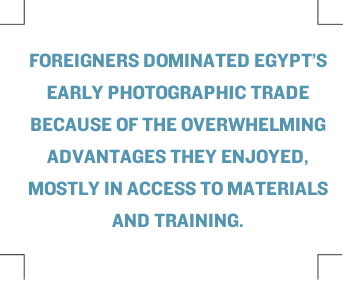 Ehab Gaddis, vice-consul for Great Britain in Luxor, remembers his grandfather as a hardworking, generous man, who until his death in 1972 presented his grandchildren on their Friday visits to the shop with a small gift of five piasters each. “We felt rich!” says Ehab. In those days Gaddis & Co. sold expensive jewelry and antiques. “It was like a museum,” Ehab recalls, “and the clients seemed like kings and queens.” Gaddis & Co. was frequented by aristocratic guests of the Winter Palace, some of whom Attiya photographed. When Ehab was around 12, he recalls, Attiya gave him a small Kodak 127 camera. Handling its leather case, Ehab promised himself he’d become a famous photographer, just like his grandfather.
Ehab Gaddis, vice-consul for Great Britain in Luxor, remembers his grandfather as a hardworking, generous man, who until his death in 1972 presented his grandchildren on their Friday visits to the shop with a small gift of five piasters each. “We felt rich!” says Ehab. In those days Gaddis & Co. sold expensive jewelry and antiques. “It was like a museum,” Ehab recalls, “and the clients seemed like kings and queens.” Gaddis & Co. was frequented by aristocratic guests of the Winter Palace, some of whom Attiya photographed. When Ehab was around 12, he recalls, Attiya gave him a small Kodak 127 camera. Handling its leather case, Ehab promised himself he’d become a famous photographer, just like his grandfather.
“Well, that didn’t happen,” he says with a laugh, but he did the next best thing: He preserved Attiya’s story, along with his precious collection of 2000 glass-plate negatives.
Attiya Gaddis himself was nothing if not resourceful, taking promotional photographs of the Winter Palace’s interiors and gardens as part of his studio-rental deal with the hotel (which was, and remains, Luxor’s best commercial location) while importing Egypt-related books from Europe for sale in the shop. The lustrous wooden housing of the unwieldy box camera belies the half-century Gaddis spent hauling it around the villages and archeological sites of Egypt. Along with photographing the tombs and temples of the Valleys of the Kings and Queens and producing prints and postcards for tourists, Attiya captured everything from the Giza pyramids in the north to the Nubian tribesmen and women of Upper Egypt in the south, long before the reservoir of the Aswan High Dam flooded much of their homeland. He covered the visits to Luxor by members of Egypt’s royal family and by foreign heads of state, including Afghani King Aman Allah and Ethiopian Emperor Haile Selassie.
Attiya also produced “genre photos” of ordinary Egyptians, which made up an important part of any Egyptian studio photographer’s stock in trade, so popular were such images with tourists and the western market. These were portraits of unnamed “types” of local tradesmen and women: barbers, farmers, water-carriers, herders, craftsmen and street vendors; “harem women,” dancing girls and “veiled women” young and old; Nubians, Bedouins and turbaned shaykhs.
 |
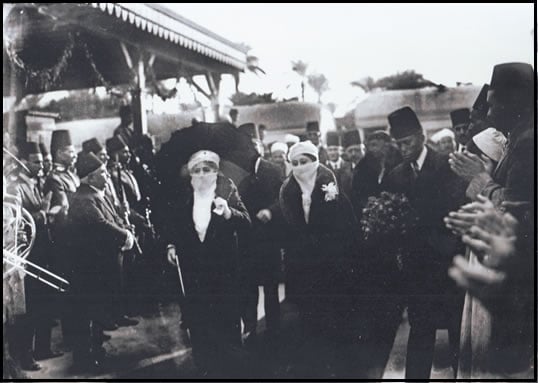 |
| In Luxor, Gaddis also often photographed tourists, celebrities and royalty. Top: a western-clad tourist poses with local water-carriers in the Ramesseum, circa 1930s. Above: A rare snapshot of Sultana Malak, wife of Egyptian Sultan Hussein Kamel, on a visit circa 1914-17. |
The genre portraits taken in studios were obviously contrived and often woodenly posed, sometimes by people costumed to suit the role and at other times by actual people in their ordinary daily or ceremonial attire. Yet Attiya’s genre portraits of his fellow Egyptians, whether made in his studio or in their villages and workplaces, remain distinctive because of the ease exhibited by his frequently smiling subjects, owing to shared language and culture. He also produced the hundreds of simple portraits of men and women of all ages and backgrounds that they used for identity cards, which Egypt’s British rulers demanded beginning in the early 1920s, and which now constitute a photographic record of ordinary people.
 |
| Since opening in 1907 as a simple studio and darkroom, Gaddis & Co. has expanded over the decades to include books, jewelry and souvenirs, and it employed the Gaddis family, notably Attiya’s son Abdullah, above, probably photographed in 1944, and Abdullah’s wife. |
Attiya’s career unfolded in concert with the events that marked 20th-century Egypt, notably among them the worldwide sensation in 1923 of the discovery of Tutankhamen’s tomb in the Valley of the Kings. The interplay of tourism, archeology and photography reached its apogee when Howard Carter opened the burial chamber. Carter had sold advance syndication rights for the excavation photographs taken by Egyptologist Harry Burton to The Times of London, which ensured their worldwide diffusion, and he hastened to make the site available to the expected flood of tourists. Gaddis was on hand when the contents of Tut’s tomb were removed, under armed guard, from the Theban necropolis for transport to the Cairo Museum.
Although tourism briefly surged thanks to the teen pharaoh’s treasures, the worldwide Great Depression of the 1930s brought Attiya’s business nearly to a halt. Things improved during World War II when Gaddis set up a temporary studio in nearby Qena to photograph the British troops garrisoned there. In the 1950s, he briefly established yet another temporary outfit near the British military base in Ismailia on the Suez Canal.
With a wife and four children to support, Attiya considered his wide-ranging activities necessary to achieve simple financial stability. From the start, he faced the same challenges as professional photographers everywhere—including a mega-competitor named George Eastman, whose introduction of the Kodak No.1 camera, launched in 1888 with the slogan “You press the button, we do the rest,” placed photography directly in the hands of the consumer. In 1900, the Kodak Brownie cost $1 (equivalent to $26.45 today), and many people who could afford to travel took one along. The same year that Gaddis opened his Winter Palace studio, George Eastman opened Africa’s first Kodak outlet in Cairo to answer the expected demand for film and print developing in one of the world’s most popular tourist destinations. (That storefront, at 20 Adly Street, endured until 2008.) Gaddis soon became one of Kodak’s first agents in Egypt.
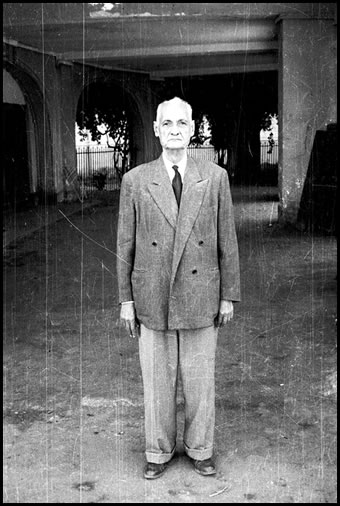 |
| Attiya himself, photographed at right in 1950, remained active in the business until his death in 1972. |
As much as Kodak gained ground, demand persisted for large-format, well-executed photographic prints as well as souvenir postcards and portraits. Tourists were the raison d’etre and most enduring clientele for Gaddis. He continued to take photographs until 1964, when his health began to fail, and he tended his shop with the help of relatives and young apprentices, selling prints and enlargements, photographic supplies, postcards, books and souvenirs until the day he died.
Ehab’s father was Attiya’s eldest son, Abdullah, and Abdullah worked as a salesperson in the shop beginning in 1940, as did his wife (Ehab’s mother) and her own father, who staffed the darkroom.
“One day,” Abdullah told the young Ehab, “your grandfather’s work will be valuable.” Ehab credits his father as the first “guardian” of the collection for having stored Attiya’s precious glass-plate negatives in a refrigerator, where they remained for 20 years before being brought in, literally, from the cold.
In 1994, a French archeologist who had seen the photographs by Gaddis and Seif that illustrated Thebes, a book by Jean Capart that was published in Brussels in 1926, visited and asked if there were more images. He was astonished by the contents of the refrigerator. “I realized my father was right,” admits Ehab. “These photos are part of Egypt’s history.” Slowly but surely, in the 1990s Ehab began digitizing his grandfather’s archive, and he published two books featuring Attiya’s work: Memories From The Past (1999) and Egypt’s Native Son (2005). The digital prints and postcards from Attiya’s collection, sold exclusively at Gaddis & Co., remain a popular item among tourists and aficionados of photography and Egypt.
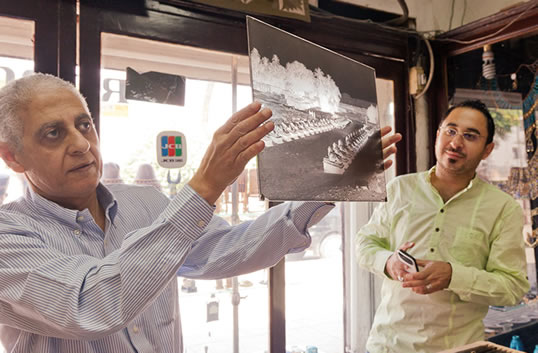 |
| Today, the family continues to run the storefront business, and Ehab Gaddis, at left, has digitized and conserved his grandfather’s images, many of which Ehab’s father, Abdullah, kept intact over two decades by storing them in a refrigerator. “These photos are part of Egypt’s history,” Ehab says. |
Although photographs of Egypt continue to captivate the world, the iconography of the distant past has lately been supplanted with the urgent present. Today, the word “Egypt” is likely to call to mind images of crowds clamoring for self-governance in 2011. Photography has played an inestimable role in both reflecting and shaping Egypt’s social realities, and there are signs that a deeper appreciation is emerging of its cultural, historic and artistic value.
Recent scholarship has drawn on period photographs to study early 20th-century subjects such as Egypt’s first nationalist movement, women in the press and the planning and architecture of the nation’s cities. Historians have begun to investigate the work of early Egyptian photographers as a window into the recent past. Attiya Gaddis’s story provides a small but crucial piece of this much larger picture, one that sheds light on the profession that influenced both the way the world sees Egypt and how Egyptians see themselves.
 |
Maria Golia (www.mariagolia.wordpress.com) is the author of Photography and Egypt (Reaktion, 2010) as well as Cairo, City of Sand (Reaktion, 2004). Her latest book, Meteorite, is forthcoming this year. She lives in downtown Cairo. |